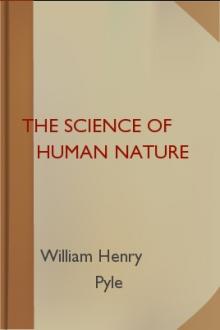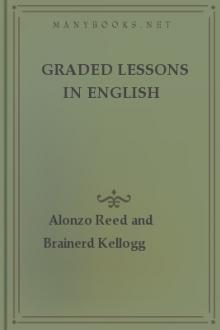The Science of Human Nature, William Henry Pyle [best pdf ebook reader .txt] 📗

- Author: William Henry Pyle
- Performer: -
Book online «The Science of Human Nature, William Henry Pyle [best pdf ebook reader .txt] 📗». Author William Henry Pyle
Method. Distribute the test-sheets and turn them face down on the desks. Allow ten minutes in all the tests. Give the following instructions:
On the sheets which have been distributed is printed a story which has certain words omitted. You are to put in the blanks the words that are omitted. The words which you write in must give the proper meaning so that the story reads correctly. Each word filled in must not only give the proper meaning to the sentence but to the story as a whole.
Material. Use the completion test-sheets, “Joe and the Fourth of July,” for grades three, four, and five; “The Trout” for grades, six, seven, and eight; and “Dr. Goldsmith’s Medicine” for the high school.
Results. In scoring the papers, allow one credit for each blank correctly filled. The norms are shown in Figures XVI, XVII, and XVIII. It will be noticed that the boys excel in the “Trout” story. This is doubtless because the story is better suited to them on the ground of their experience and interest.
Figure XVI—Completion Test—“Joe and the Fourth of July”
JOE AND THE FOURTH OF JULYJoe ran[6] errands for his mother and took care of the baby until by the Fourth of July his penny grew to be a dime. The day before the Fourth, he went down town all by himself to get his fire works. There were so many kinds he hardly knew which to buy. The clerk knew that it takes a long time to decide, for he had been a boy himself not very long ago. So he helped Joe to select the very best kinds. “When are you going to fire them off?” asked the clerk. “I will fire them very early to-morrow,” said the boy. So that night Joe set the alarm clock, and the next morning got up early to fire his firecrackers.
[6] The italicized words and letters are left blank in the test sheets.
Figure XVII—Completion Test—“The Trout”
THE TROUTThe trout is a fine fish. Once a big trout lived in a pool close by a spring. He used to stay under the bank with only his head showing. His wide-open eyes shone like jewels. I tried to catch him. I would creep up to the edge of the pool where I could see his bright eyes looking up.
I caught a grasshopper and threw it over to him. Then there was a splash in the water and the grasshopper was gone. I did this two or three times. Each time I saw the rush and splash and saw the bait had been taken.
So I put the same bait on my hook and threw it over into the water. But all was silent. The fish was an old one and had grown very wise. I did this day after day with the same luck. The trout knew there was a hook hidden in the bait.
DOCTOR GOLDSMITH’S MEDICINEThis is a story of good medicine. Most medicine is bad to take, but this was so good that the sick man wished for more.
One day a poor woman went to Doctor Goldsmith and asked him to go to see her sick husband. “He is very sick,” she said, “and I can not get him to eat anything.”
So Doctor Goldsmith went to see him. The doctor saw at once that the reason why the man could not eat was because he was so poor that he had not been able to buy good food.
Then he said to the woman, “Come to my house this evening and I will give you some medicine for your husband.”
The woman went in the evening and the doctor gave her a small paper box tied up tight. “It is very heavy,” she said. “May I see what it looks like?” “No,” said the doctor, “wait until you get home.” When she got home, and she and her husband opened the box so that he could take the first dose of medicine,—what do you think they saw? The box was filled with silver money. This was the good doctor’s medicine.
Importance of Mental Differences. (1) In school work. One of the important results that come from a knowledge of the mental differences in children is that we are able to classify them better. When a child enters school he should be allowed to proceed through the course as fast as his development warrants. Some children can do an eight-year course in six years; others require ten years; still others can never do it. The great majority, of course, can do it in eight years.
Figure XVIII—Completion Test—“Dr. Goldsmith’s Medicine”
Norms for adults, as obtained from university students, are:
Test Men Women Substitution Test 29.1 32.2 Rote Memory, Concrete 28.5 28.6 Rote Memory, Abstract 28.4 27.9 Free Association 51.5 49.3 Completion, Dr. Goldsmith’s Medicine 48.1 49.0 Word Building 20.5 20.1 Logical Memory, Costly Temper 64.0 69.6Figure XIX—Frequency Surfaces—Comparing Fourth Grade with High School
The numbers along the base represent mental age; those at the left, the number of pupils of the respective ages.
It may be thought that a child’s success in school branches is a sufficient measure of his ability and that no special mental measurements are needed. This is a mistake. Many factors contribute to success in school work. Ability is only one of these factors, and should be specially and independently determined by suitable tests. Children may fail in school branches because of being poorly started or started at the wrong time, because of poor teaching, sickness, moving from one school to another, etc. On the other hand, children of poor ability may succeed at school because of much help at home. Therefore special mental tests will help in determining to what extent original mental ability is a factor in the success or failure of the different pupils.
As far as possible, the children of the same grade should have about the same ability; but such is seldom the case. In a recent psychological study of a school system, the author found wide differences in ability in the same grade. The distribution of abilities found in the fourth grade and in the high school are shown in Figure XIX. It will be seen that in the fourth grade pupils are found with ability equal to that of some in the high school. Of course to some extent such a condition is unavoidable, for a pupil must establish certain habits and acquire certain knowledge before passing from one grade to another. However, much of the wide variation in ability now found in the same grade of a school could be avoided if the teacher had accurate knowledge of the pupils’ abilities. When a teacher learns that a child who is doing poorly in school really has ability, she is often able to get from that pupil the work of which he is capable. It has been demonstrated by experience that accurate measures of children’s abilities are a great help in gradation and classification.
A knowledge of mental differences is also an aid in the actual teaching of the children. The instance mentioned at the close of the last paragraph is an example. A knowledge of the differences among the mental functions of the same pupil is especially helpful. It has been pointed out that the different mental functions in the same pupil are sometimes unequally developed. Sometimes considerable differences exist in the same pupil with respect to learning capacity, the different aspects of memory, association, imagination, and attention. When a teacher knows of these differences, she can better direct the work of the pupils.
For example, if a pupil have a very poor memory, the teacher can help him by aiding him to secure the advantage that comes from close and concentrated attention, frequent repetitions, logical organization, etc. On the other hand, she can help the brilliant student by preventing him from being satisfied with hastily secured, superficial knowledge, and by encouraging him to make proper use of his unusual powers in going deeper and more extensively into the school subjects than is possible for the ordinary student. In many ways a teacher can be helpful to her pupils if she has an accurate knowledge of their mental abilities.
(2) In life occupations. Extreme variations in ability should certainly be considered in choosing one’s life work. Only persons of the highest ability should go into science, law, medicine, or teaching. Many occupations demand special kinds of ability, special types of reaction, of attention, imagination, etc. For example, the operation of a telephone exchange demands a person of quick and steady reaction. The work of a motorman on a street car demands a person having the broad type of attention, the type of attention that enables one to keep in mind many details at the same time. Scientific work demands the type of concentrated attention. As far as it is possible, occupations demanding special types of ability should be filled by people possessing these abilities. It is best for all concerned if each person is doing what he can do best. It is true that many occupations do not call for special types of ability. And therefore, as far as ability is concerned, a person could do as well in one of these occupations as in another. The time will sometime come when we shall know the special abilities demanded by the different occupations and professions, and by suitable tests shall be able to determine what people possess the required qualifications.
The schools should always be on the lookout for unusual ability. Children that are far superior to others of the same age should be allowed to advance as fast as their superior ability makes possible, and should be held up to a high order of work. Such superior people should be, as far as possible, in the same classes, so that they can the more easily be given the kind and amount of work that they need. The schools should find the children of unusual special ability, such as ability in drawing, painting, singing, playing musical instruments, mechanical invention, etc. Some provision should be made for the proper development and training of these unusual abilities. Society cannot afford to lose any spark of genius wherever found. Moreover, the individual will be happier if developed and trained along the line of his special ability.
Subnormal Children. A small percentage of children are of such low mentality that they cannot do the ordinary school work. As soon as such children can be picked out with certainty, they should be taken out of the regular classes and put into special classes. It is a mistake to try to get them to do the regular school work. They cannot do it, and they only waste the teacher’s time and usually give her much trouble. Besides, they waste their own time; for while they cannot do the ordinary school work, they can do other things, perhaps work of a manual nature. The education of such people should, therefore, be in the direction of simple manual occupations.
For detecting such children, in addition to the tests given above, elaborate tests for individual examination have been devised. The most widely used is a series known as the Binet-Simon tests. A special group of tests is provided for the children of each age. If a child can pass the tests for his age, he is considered normal. If he can pass only the tests three years or more below his age, he is usually considered subnormal. But a child’s fate should not depend solely





Comments (0)